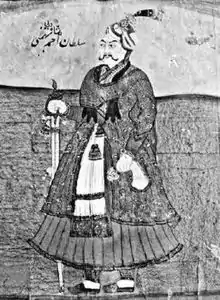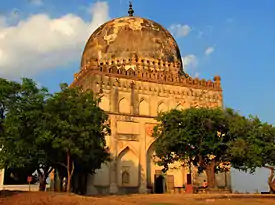Ahmad Shah I Wali
Ahmed Shah Al Wali Bahamani ruled the Kingdom of Bidar from 1 October 1422 to 17 April 1436 and was a great patron of arts and culture.[1] He brought artisans from Iran, including the metal-worker Abdulla-bin-Kaiser, who was the master of Bidriware, the inlaying of zinc alloy with silver and gold.[2]
| Ahmed Shah Bahmani I | |
|---|---|
| Wali | |
 | |
| 9th Sultan of the Bahmani Sultanate | |
| Reign | 1 October 1422 – 17 April 1436 |
| Predecessor | Taj ud-Din Firuz Shah |
| Successor | Ala-ud-Din Ahmed Shah Bahmani |
| Burial | |


Reign
Ahmed Shah's, and his empress's, tomb is located in Ashtur village, Bidar District,[1][3] and is the subject of an annual urs, or anniversary of death festival.[1][4]
During the reign of Ahmed Shah, in 1432, the Bahmani capital shifted to Bidar, and Khwaja Bandenawaz (d. 1422), the most well-known Sufi of the Deccan, is supposed to have been one of the causes for this. The Bahmani kings had close ties with Sufi saints, and Ahmed Shah continued the tradition but he was also considered a saint; the only king to be treated as such by his followers. His tomb in the funerary complex of Ashtur, just outside Bidar, is venerated by Muslims, who consider him to be a wali (friend of God). Ahmed Shah's tomb has well-preserved murals and verses from the Quran. Frontline</ref>
Ahmed Shah fought battles against Vijayanagar[5] (1423), Warangal (1424–1425), Malwa (an ancient kingdom whose capital was situated in Ujjain) (1425–1435), and against Gujarat (1425–1435).<ref>
Beliefs
He was religiously inclined and fond of Sufi saints.[6] He is referred to by the title Wali.[7]
Issue
The king had four sons. Two of his sons died during his reign.
References
Citations
- Staff (5 March 2007) "Symbol of communal harmony" The Hindu
- Nathanael, M. P. (20 January 2002) "The Sunday Tribune: Spectrum: Travel: Bewitched by Bidar" The Tribune, Chandigarh, India
- "Bidar:Tomb of Ahmad Shah Baihmani" Institute of Oriental Culture Japan
- Desai, Rishikesh Bahadur (18 April 2005) "A centre for communal harmony comes alive" The Hindu
- Sen, Sailendra (2013). A Textbook of Medieval Indian History. Primus Books. pp. 106–108. ISBN 978-9-38060-734-4.
- Yazdani, 1947, pp. 114.
- Yazdani, 1947, pp. 115.
8. https://frontline.thehindu.com/arts-and-culture/heritage/article25296303.ece
